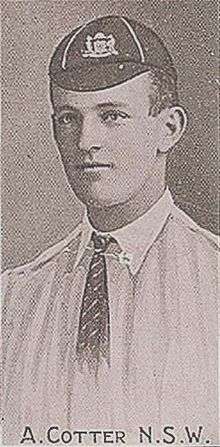Tibby Cotter
 | ||||||||||||||||||||||||||||||||||||||||
| Cricket information | ||||||||||||||||||||||||||||||||||||||||
|---|---|---|---|---|---|---|---|---|---|---|---|---|---|---|---|---|---|---|---|---|---|---|---|---|---|---|---|---|---|---|---|---|---|---|---|---|---|---|---|---|
| Batting style | Right-hand bat | |||||||||||||||||||||||||||||||||||||||
| Bowling style | Right-arm fast | |||||||||||||||||||||||||||||||||||||||
| International information | ||||||||||||||||||||||||||||||||||||||||
| National side | ||||||||||||||||||||||||||||||||||||||||
| Career statistics | ||||||||||||||||||||||||||||||||||||||||
| ||||||||||||||||||||||||||||||||||||||||
| Source: | ||||||||||||||||||||||||||||||||||||||||
Albert "Tibby" Cotter (born 3 December 1883 in Sydney, died 31 October 1917 in Beersheba) was an Australian cricketer who played in 21 Tests between 1904 and 1912.
Arguably the best fast bowler through the first decade of the 20th century he had a reputation for breaking stumps. Early moving film of his action clearly shows a slinging action that was to cause controversy in England.
While regarded as the fastest of his era in Australia (his pace saw him nicknamed "'Terror' Cotter" by English fans) he did not always have the control to back it up, hitting W.G.Grace on the body with a full toss on his first tour of England.
He took eight or more wickets in a match four times from his 21 Tests and his strike rate of 52 ranks up with the best.
Cotter missed the tri-nations tour to England in 1912 when he was among the six players who refused to tour due to a dispute with the Board of Control. He was never to play for Australia again.

Cotter joined the Australian Imperial Force (AIF) in April 1915, aged 31. The enlistment of a former sporting champion was seen as powerful publicity for the AIF recruiting campaign.
Despite having no great riding ability, he was accepted into the 1st Australian Light Horse Regiment; he took a late part in the Gallipoli campaign. Later he transferred to the 12th Light Horse and was commended for his “fine work under heavy fire” during the second battle of Gaza. The official history remarked: “he behaved in action as a man without fear”. He declined promotion.
On 31 October 1917 the 4th Light Horse Brigade, of which the 12th Regiment was part, captured Beersheba by a brilliant cavalry-style charge. Cotter was there as a stretcher-bearer. At the end of the charge, as troops dismounted to engage the enemy, a Turk shot Cotter dead at close range.
Legacy
In February 2015, the Albert Cotter Bridge opened across Anzac Parade, Sydney opposite the Sydney Cricket Ground.